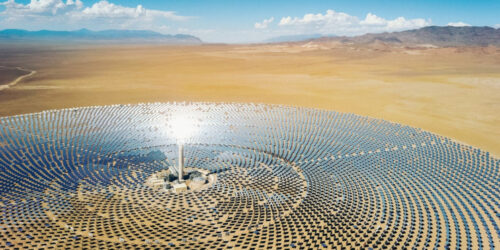The energy generation of ferroelectric crystals in solar cells can be increased by a factor of a thousand, thanks to a new innovation involving the arrangement of thin layers of the materials, according to a statement from Martin Luther University Halle-Wittenberg (MLU).
Researchers from MLU found that with alternately placed crystalline layers of barium titanate, strontium titanate, and calcium titanate, they could greatly increase the efficiency of solar panels. Their findings are published in the journal Science Advances.
Most solar cells are made out of silicon due to its low cost and relative efficiency; however, limits to the material’s overall efficiency have led to researchers experimenting with new materials, including ferroelectric crystals.
One of the benefits of ferroelectric crystals is that they do not require a pn junction, meaning no positively and negatively doped layers — as is the case with silicon solar cells.
However, pure barium titanate, a ferroelectric crystal tested by the MLU researchers, for example, absorbs little sunlight. By experimenting with different combinations of materials, the scientists found that they could combine extremely thin layers of different materials to significantly increase their solar energy yield.
“The important thing here is that a ferroelectric material is alternated with a paraelectric material. Although the latter does not have separated charges, it can become ferroelectric under certain conditions, for example at low temperatures or when its chemical structure is slightly modified,” Dr Akash Bhatnagar, from MLU’s Centre for Innovation Competence SiLi-nano, explained in the MLU press release.
Layered power surge
Bhatnagar and his team embedded barium titanate between strontium titanate and calcium titanate by vaporizing the crystals with a high-power laser and redepositing them on carrier substrates. The resulting material was composed of 500 layers and was 200 nanometers thick.
The researchers found that their layered material enabled a current flow 1,000 times stronger than measured in pure barium titanate of the equivalent thickness.
“The interaction between the lattice layers appears to lead to a much higher permittivity – in other words, the electrons are able to flow much more easily due to the excitation by the light photons,” Bhatnagar explained.
The team also showed that the measurements remained almost constant over a six-month period, meaning the material may be robust enough for commercial application. Next, they will continue to research the exact cause of the photoelectric effect in their layered material, with a view to eventual deployment at a mass scale.
Their work promises to be part of a potential revolution in ferroelectric materials, with possible applications in computer memory, capacitors, and other electronic devices.





